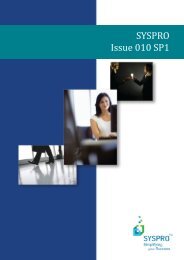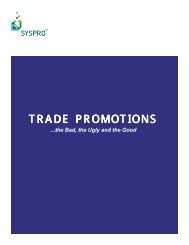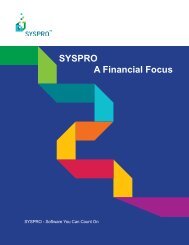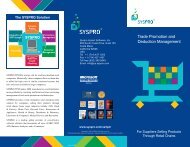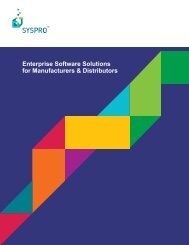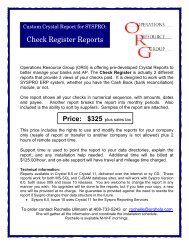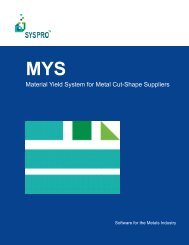Teach Yourself e.net - Syspro
Teach Yourself e.net - Syspro
Teach Yourself e.net - Syspro
Create successful ePaper yourself
Turn your PDF publications into a flip-book with our unique Google optimized e-Paper software.
5.2. Query Class<br />
There are five Methods within the Query class structure: Query, Browse, Fetch,<br />
NextKey, PreviousKey.<br />
Use the e.<strong>net</strong> Diagnostics suite and open the 'Harness' tool to see the method options<br />
displayed when you select the Query class:<br />
By selecting each different method and clicking on the business object dropdown menu<br />
you can see which business objects are available for that particular method within the<br />
Query class.<br />
5.2.1. Query.Query<br />
Syntax:<br />
Query.Query(UserID, BusinessObject, XmlIn)<br />
The Query method enables generic access to any Query business object in order to return<br />
data in the form of an XML string.<br />
The return data is specified by passing parameters in an XML string via XmlIn. The<br />
structure and parameters allowed in XmlIn is dependent on the business object being<br />
called.<br />
Business objects available to this method can be found in the Business Object Reference<br />
Library list available on the SYSPRO SupportZone e.<strong>net</strong> solutions menu.<br />
Use the e.<strong>net</strong> Diagnostics suite's Harness and select Query.Query. Now select the<br />
APSQRY business object:<br />
Click on the Load XML button to view the sample XmlIn.<br />
By using the e.<strong>net</strong> Diagnostics suite's Harness tool you can view and edit the sample<br />
XmlIn and process it through the e.<strong>net</strong> solutions application server, receiving the XmlOut<br />
5–10



